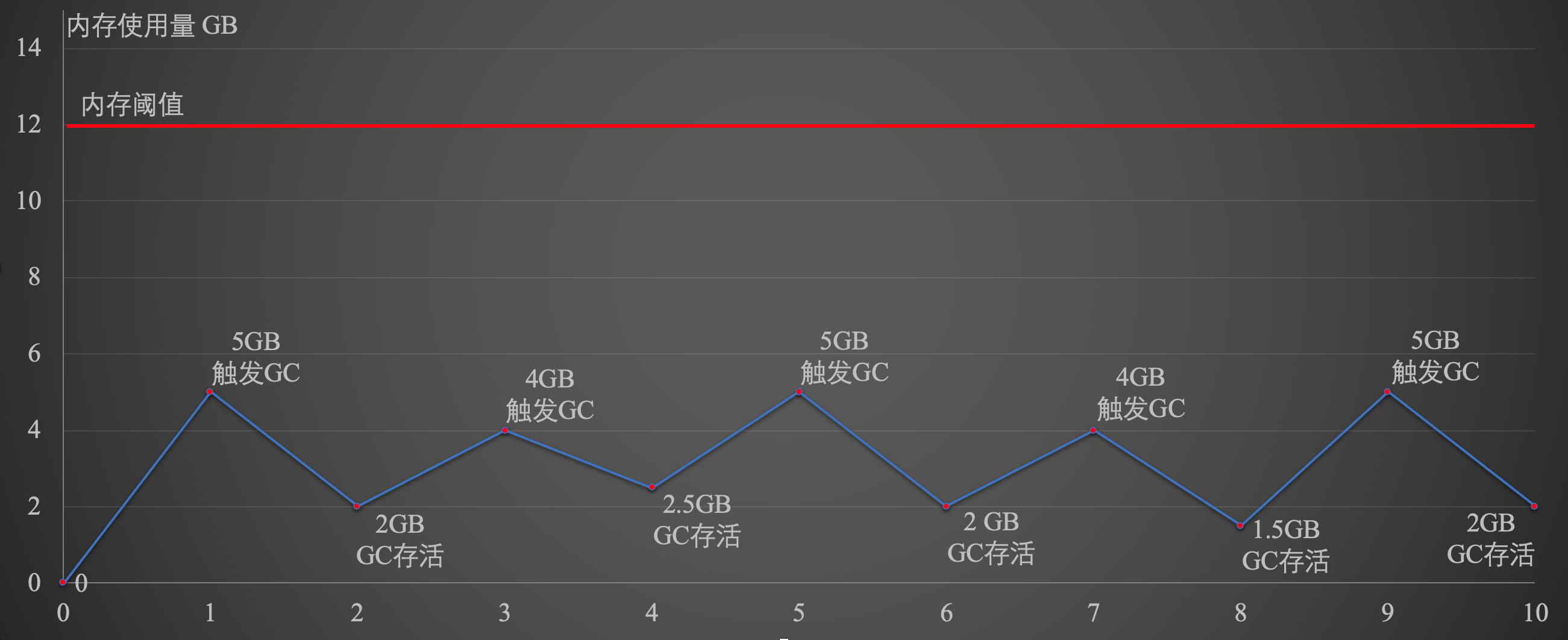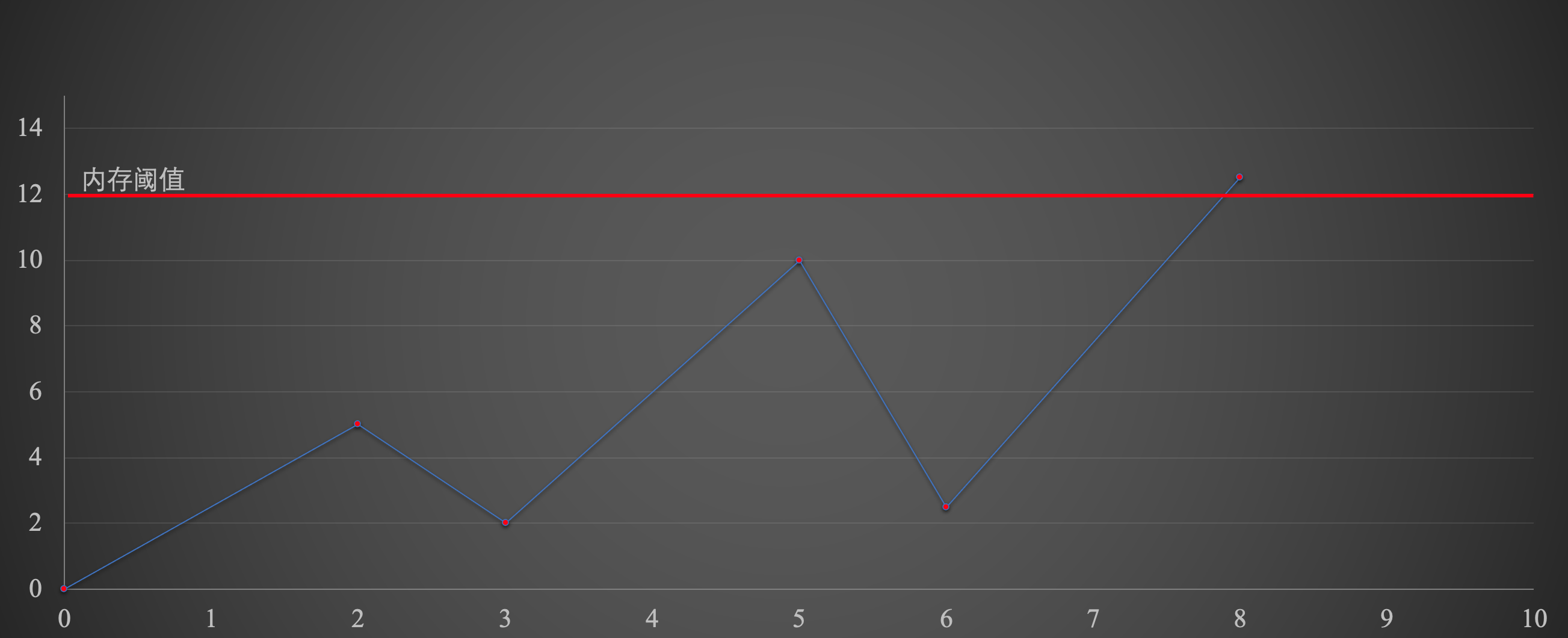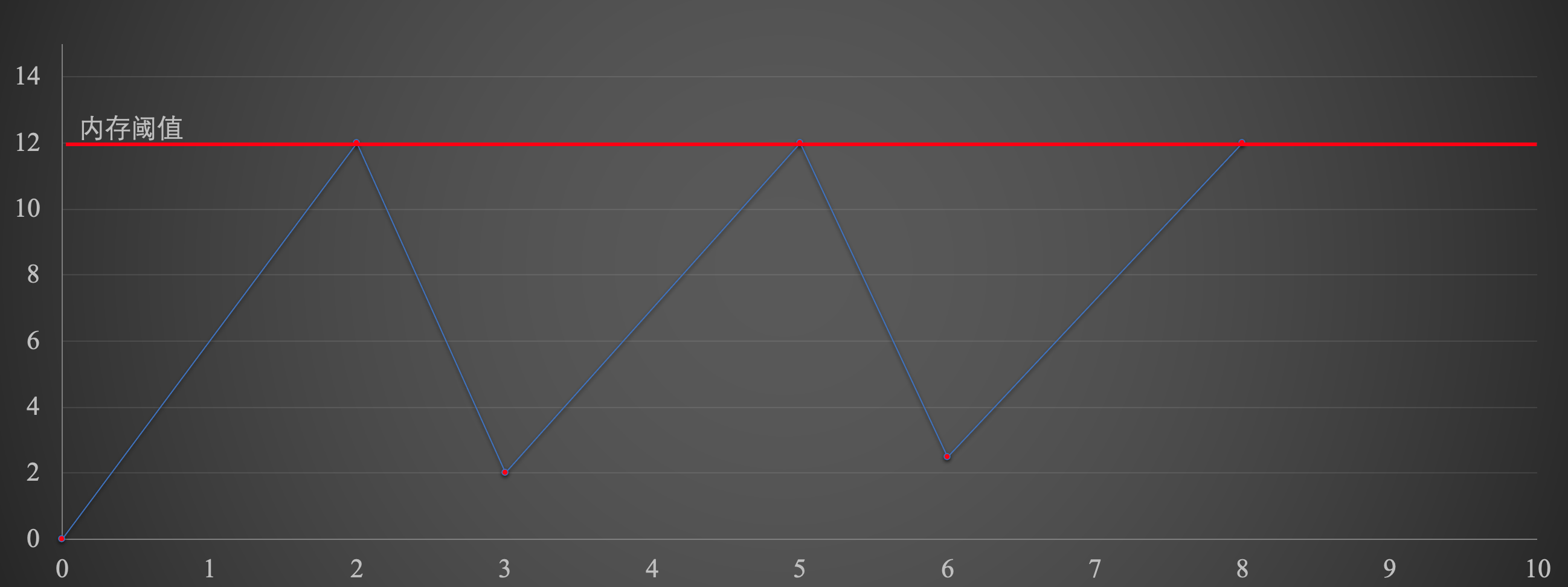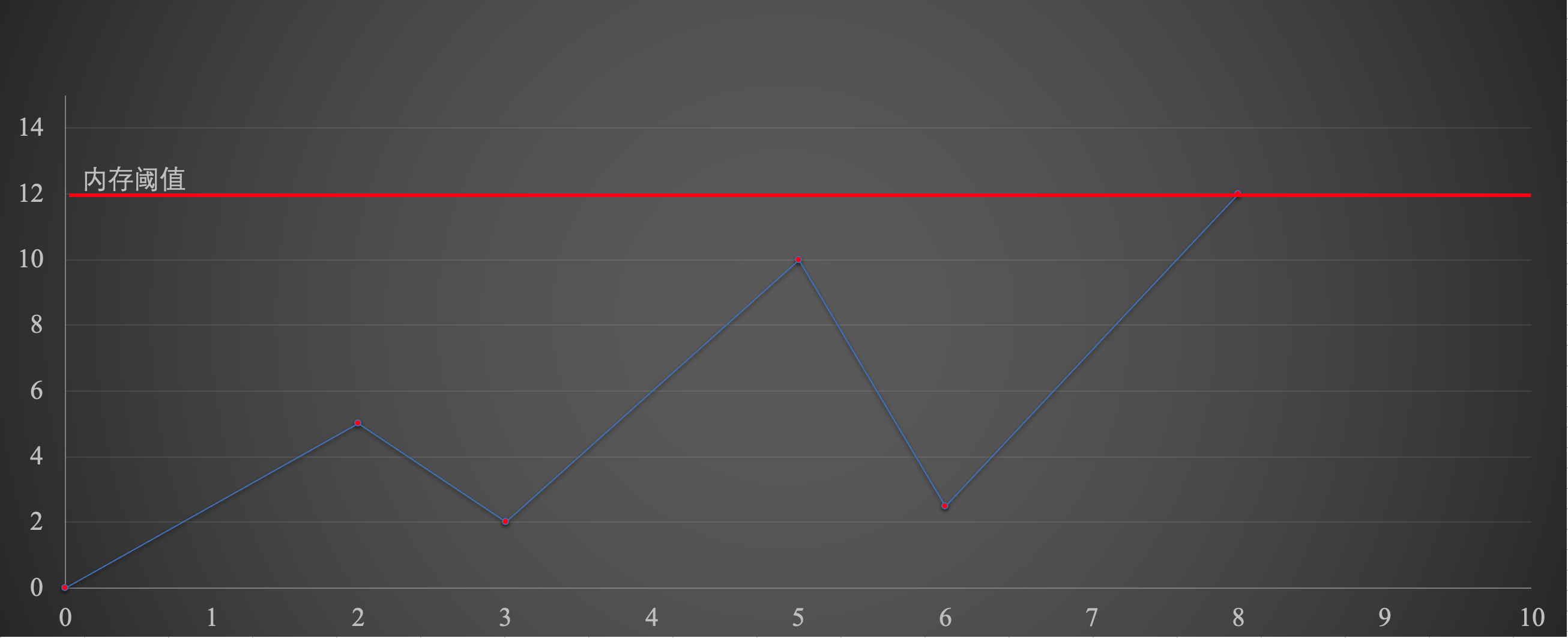简单来说,SetMaxHeap提供了一种可以设置固定触发阈值的 GC(Garbage Collection垃圾回收)方式
官方源码链接 https://go-review.googlesource.com/c/go/+/227767/3
可以解决什么问题?
大量临时对象分配导致的GC触发频率过高,GC后实际存活的对象较少,
或者机器内存较充足,希望使用剩余内存,降低GC频率的场景

为什么要降低GC频率?
GC会STW(Stop The World),对于时延敏感场景,在一个周期内连续触发两轮GC,那么STW和GC占用的CPU资源都会造成很大的影响,SetMaxHeap并不一定是完美的,在某些场景下做了些权衡,官方也在进行相关的实验,当前方案仍没有合入主版本。
先看下如果没有SetMaxHeap,对于如上所述的场景的解决方案
这里简单说下GC的几个值的含义,可通过GODEBUG=gctrace=1获得如下数据
gc 16 @1.106s 3%: 0.010+19+0.038 ms clock, 0.21+0.29/95/266+0.76 ms cpu, 128->132->67 MB, 135 MB goal, 20 P
gc 17 @1.236s 3%: 0.010+20+0.040 ms clock, 0.21+0.37/100/267+0.81 ms cpu, 129->132->67 MB, 135 MB goal, 20 P
这里只关注128->132->67 MB 135 MB goal ,
分别为 GC开始时内存使用量 -> GC标记完成时内存使用量 -> GC标记完成时的存活内存量 本轮GC标记完成时的预期内存使用量(上一轮GC完成时确定)
引用GC peace设计文档中的一张图来说明

对应关系如下:
-
GC开始时内存使用量:
GC trigger -
GC标记完成时内存使用量:
Heap size at GC completion -
GC标记完成时的存活内存量:图中标记的
Previous marked heap size为上一轮的GC标记完成时的存活内存量 -
本轮GC标记完成时的预期内存使用量:
Goal heap size
简单说下GC pacing(信用机制)
注:基于自己的理解做了些简化,如有错误还请指出
GC pacing有两个目标,
-
|Ha-Hg|最小 -
GC使用的cpu资源约为总数的25%
那么当一轮GC完成时,如何只根据本轮GC存活量去实现这两个小目标呢?
这里实际是根据当前的一些数据或状态去预估“未来”,所有会存在些误差
首先确定gc Goal goal = memstats.heap_marked + memstats.heap_marked*uint64(gcpercent)/100
heap_marked为本轮GC存活量,gcpercent默认为100,可以通过环境变量GOGC=100或者debug.SetGCPercent(100) 来设置
那么默认情况下 goal = 2 * heap_marked
gc_trigger是与goal相关的一个值(gc_trigger大约为goal的90%左右),每轮GC标记完成时,会根据|Ha-Hg|和实际使用的cpu资源 动态调整gc_trigger与goal的差值
goal与gc_trigger的差值即为,为GC期间分配的对象所预留的空间
GC pacing还会预估下一轮GC发生时,需要扫描对象对象的总量,进而换算为下一轮GC所需的工作量,进而计算出mark assist的值
本轮GC触发(gc_trigger),到本轮的goal期间,需要尽力完成GC mark 标记操作,所以当GC期间,某个goroutine分配大量内存时,就会被拉去做mark assist工作,先进行GC mark标记赚取足够的信用值后,才能分配对应大小的对象
根据本轮GC存活的内存量(heap_marked)和下一轮GC触发的阈值(gc_trigger)计算sweep assist的值,本轮GC完成,到下一轮GC触发(gc_trigger)时,需要尽力刚好完成sweep清扫操作
预估下一轮GC所需的工作量的方式如下:
// heap_scan is the number of bytes of "scannable" heap. This
// is the live heap (as counted by heap_live), but omitting
// no-scan objects and no-scan tails of objects.
//
// Whenever this is updated, call gcController.revise().
heap_scan uint64
// Compute the expected scan work remaining.
//
// This is estimated based on the expected
// steady-state scannable heap. For example, with
// GOGC=100, only half of the scannable heap is
// expected to be live, so that's what we target.
//
// (This is a float calculation to avoid overflowing on
// 100*heap_scan.)
scanWorkExpected := int64(float64(memstats.heap_scan) * 100 / float64(100+gcpercent))
如何解决问题
继续分析文章开头的问题,如何充分利用剩余内存,降低GC频率和GC对CPU的资源消耗
增大 gcpercent?
如上图可以看出,GC后,存活的对象为2GB左右,如果将gcpercent设置为400,那么就可以将下一轮GC触发阈值提升到10GB左右

前面一轮看起来很好,提升了GC触发的阈值到10GB,但是如果某一轮GC后的存活对象到达2.5GB的时候,那么下一轮GC触发的阈值,将会超过内存阈值,造成OOM(Out of Memory),进而导致程序崩溃。
关闭GC,监控堆内存使用状态,手动进行GC?
可以通过GOGC=off或者debug.SetGCPercent(-1)来关闭GC
可以通过进程外监控内存使用状态,使用信号触发的方式通知程序,或ReadMemStats、或linkname runtime.heapRetained等方式进行堆内存使用的监测
可以通过调用runtime.GC()或者debug.FreeOSMemory()来手动进行GC。
这里还需要说几个事情来解释这个方案所存在的问题
通过GOGC=off或者debug.SetGCPercent(-1)是如何关闭GC的?
gc 4 @1.006s 0%: 0.033+5.6+0.024 ms clock, 0.27+4.4/11/25+0.19 ms cpu, 428->428->16 MB, 17592186044415 MB goal, 8 P (forced)
通过GC trace可以看出,上面所说的goal变成了一个很诡异的值17592186044415
实际上关闭GC后,Go会将goal设置为一个极大值^uint64(0),那么对应的GC触发阈值也被调成了一个极大值,这种处理方式看起来也没什么问题,将阈值调大,预期永远不会再触发GC
^uint64(0)>>20 == 17592186044415 MB
那么如果在关闭GC的情况下,手动调用runtime.GC()会导致什么呢?
由于goal和gc_trigger被设置成了极大值,而mark assist和sweep assist仍会按照这个错误的值去计算,导致assist的工作量变大,这一点可以从trace中进行证明


可以看到很诡异的trace图,这里不做深究,该方案与GC pacing信用机制不兼容
记住,不要在关闭GC的情况下手动触发GC,至少在当前Go1.14版本中仍存在这个问题
本文的主角-- SetMaxHeap
SetMaxHeap的实现原理,简单来说是强行控制了goal的值
注:SetMaxHeap,本质上是一个软限制,并不能解决极端场景下的OOM,可以配合内存监控和debug.FreeOSMemory()使用
SetMaxHeap控制的是堆内存大小,Go中除了堆内存还分配了如下内存,所以实际使用过程中,与实际硬件内存阈值之间需要留有一部分余量。
stacks_sys uint64 // only counts newosproc0 stack in mstats; differs from MemStats.StackSys
mspan_sys uint64
mcache_sys uint64
buckhash_sys uint64 // profiling bucket hash table
gc_sys uint64 // updated atomically or during STW
other_sys uint64 // updated atomically or during STW
对于文章开始所述问题,使用SetMaxHeap后,预期的GC过程大概是这个样子
简单用法1
notify := make(chan struct{}, 1) // 先不管这个notify
debug.SetMaxHeap(12<<30, notify) // 设置阈值为12GB
debug.SetGCPercent(-1) // 该方案实现过程中对关闭GC的情况做了兼容,可以这样使用
该方法简单粗暴,直接将goal设置为了固定值

注:通过上文所讲,触发GC实际上是gc_trigger,所以当阈值设置为12GB时,会提前一点触发GC,这里为了描述方便,近似认为gc_trigger=goal
简单用法2
notify := make(chan struct{}, 1) // 先不管这个notify
debug.SetMaxHeap(12<<30, notify) // 设置阈值为12GB
当不关闭GC时,SetMaxHeap的逻辑是,goal仍按照gcpercent进行计算,当goal小于SetMaxHeap阈值时不进行处理;当goal大于SetMaxHeap阈值时,将goal限制为SetMaxHeap阈值

注:通过上文所讲,触发GC实际上是gc_trigger,所以当阈值设置为12GB时,会提前一点触发GC,这里为了描述方便,近似认为gc_trigger=goal
获取代码
切换到go1.14分支,作者选择了git checkout go1.14.5
选择官方提供的cherry-pick方式(可能需要梯子,文件改动不多,我后面会列出具体改动)
git fetch "https://go.googlesource.com/go" refs/changes/67/227767/3 && git cherry-pick FETCH_HEAD
需要重新编译Go源码
实现原理
函数原型
func SetMaxHeap(bytes uintptr, notify chan<- struct{}) uintptr
入参bytes为要设置的阈值
notify 简单理解为 GC的策略 发生变化时会向channel发送通知,后续源码可以看出“策略”具体指哪些内容
Whenever the garbage collector's scheduling policy changes as a result of this heap limit (that is, the result that would be returned by ReadGCPolicy changes), the garbage collector will send to the notify channel.
返回值为本次设置之前的MaxHeap值
官方推荐用法
notify := make(chan struct{}, 1)
var gcp GCPolicy
prev := SetMaxHeap(limit, notify)
// Check that that notified us of heap pressure.
select {
case <-notify:
ReadGCPolicy(&gcp) // 获取变化后的GC策略信息
default:
t.Errorf("missing GC pressure notification")
}
$GOROOT/src/runtime/debug/garbage.go
// SetGCPercent sets the garbage collection target percentage:
// a collection is triggered when the ratio of freshly allocated data
// to live data remaining after the previous collection reaches this percentage.
// SetGCPercent returns the previous setting.
// The initial setting is the value of the GOGC environment variable
// at startup, or 100 if the variable is not set.
// A negative percentage disables triggering garbage collection
// based on the ratio of fresh allocation to previously live heap.
// However, GC can still be explicitly triggered by runtime.GC and
// similar functions, or by the maximum heap size set by SetMaxHeap.
func SetGCPercent(percent int) int {
return int(setGCPercent(int32(percent)))
}
// GCPolicy reports the garbage collector's policy for controlling the
// heap size and scheduling garbage collection work.
type GCPolicy struct {
// GCPercent is the current value of GOGC, as set by the GOGC
// environment variable or SetGCPercent.
//
// If triggering GC by relative heap growth is disabled, this
// will be -1.
GCPercent int
// MaxHeapBytes is the current soft heap limit set by
// SetMaxHeap, in bytes.
//
// If there is no heap limit set, this will be ^uintptr(0).
MaxHeapBytes uintptr
// AvailGCPercent is the heap space available for allocation
// before the next GC, as a percent of the heap used at the
// end of the previous garbage collection. It measures memory
// pressure and how hard the garbage collector must work to
// achieve the heap size goals set by GCPercent and
// MaxHeapBytes.
//
// For example, if AvailGCPercent is 100, then at the end of
// the previous garbage collection, the space available for
// allocation before the next GC was the same as the space
// used. If AvailGCPercent is 20, then the space available is
// only a 20% of the space used.
//
// AvailGCPercent is directly comparable with GCPercent.
//
// If AvailGCPercent >= GCPercent, the garbage collector is
// not under pressure and can amortize the cost of garbage
// collection by allowing the heap to grow in proportion to
// how much is used.
//
// If AvailGCPercent < GCPercent, the garbage collector is
// under pressure and must run more frequently to keep the
// heap size under MaxHeapBytes. Smaller values of
// AvailGCPercent indicate greater pressure. In this case, the
// application should shed load and reduce its live heap size
// to relieve memory pressure.
//
// AvailGCPercent is always >= 0.
AvailGCPercent int
}
// 只是针对Go堆内存的软限制,默认不开启
// SetMaxHeap sets a soft limit on the size of the Go heap and returns
// the previous setting. By default, there is no limit.
//
// If a max heap is set, the garbage collector will endeavor to keep
// the heap size under the specified size, even if this is lower than
// would normally be determined by GOGC (see SetGCPercent).
//
// 当由于SetMaxHeap导致垃圾收集器的策略发生变化(ReadGCPolicy返回的结果发生更改)时,
// 会向notify发生通知
// Whenever the garbage collector's scheduling policy changes as a
// result of this heap limit (that is, the result that would be
// returned by ReadGCPolicy changes), the garbage collector will send
// to the notify channel. This is a non-blocking send, so this should
// be a single-element buffered channel, though this is not required.
// Only a single channel may be registered for notifications at a
// time; SetMaxHeap replaces any previously registered channel.
//
// The application is strongly encouraged to respond to this
// notification by calling ReadGCPolicy and, if AvailGCPercent is less
// than GCPercent, shedding load to reduce its live heap size. Setting
// a maximum heap size limits the garbage collector's ability to
// amortize the cost of garbage collection when the heap reaches the
// heap size limit. This is particularly important in
// request-processing systems, where increasing pressure on the
// garbage collector reduces CPU time available to the application,
// making it less able to complete work, leading to even more pressure
// on the garbage collector. The application must shed load to avoid
// this "GC death spiral".
//
// The limit set by SetMaxHeap is soft. If the garbage collector would
// consume too much CPU to keep the heap under this limit (leading to
// "thrashing"), it will allow the heap to grow larger than the
// specified max heap.
//
// 堆内存大小不是包括进程内存占用的所有内容,它不包括stacks,C分配的内存和许多runtime内部使用的结构。
// The heap size does not include everything in the process's memory
// footprint. Notably, it does not include stacks, C-allocated memory,
// or many runtime-internal structures.
//
// 当bytes== ^uintptr(0)时,关闭SetMaxHeap,仅当这种情况下notify可以为nil
// To disable the heap limit, pass ^uintptr(0) for the bytes argument.
// In this case, notify can be nil.
//
// 如果只依赖SetMaxHeap去触发过GC,在设置阈值后调用SetGCPercent(-1)来关闭原生GC
// To depend only on the heap limit to trigger garbage collection,
// call SetGCPercent(-1) after setting a heap limit.
func SetMaxHeap(bytes uintptr, notify chan<- struct{}) uintptr {
// 关闭该功能
if bytes == ^uintptr(0) {
return gcSetMaxHeap(bytes, nil)
}
// 开启该功能时,应传入一个notify
if notify == nil {
panic("SetMaxHeap requires a non-nil notify channel")
}
return gcSetMaxHeap(bytes, notify)
}
// gcSetMaxHeap is provided by package runtime.
// 在这里只进行函数定义,在runtime中实现具体功能
func gcSetMaxHeap(bytes uintptr, notify chan<- struct{}) uintptr
// ReadGCPolicy reads the garbage collector's current policy for
// managing the heap size. This includes static settings controlled by
// the application and dynamic policy determined by heap usage.
// ReadGCPolicy读取垃圾收集器当前的用于管理堆大小的策略,
// 这包括由应用程序控制的静态设置和由堆使用情况确定的动态策略,后面可以看下具体返回的是什么
func ReadGCPolicy(gcp *GCPolicy) {
gcp.GCPercent, gcp.MaxHeapBytes, gcp.AvailGCPercent = gcReadPolicy()
}
// gcReadPolicy is provided by package runtime.
// 在这里只进行函数定义,在runtime中实现具体功能
func gcReadPolicy() (gogc int, maxHeap uintptr, egogc int)
$GOROOT/src/runtime/mgc.go
// To begin with, maxHeap is infinity.
// 默认关闭,为极大值
var maxHeap uintptr = ^uintptr(0)
func gcinit() {
if unsafe.Sizeof(workbuf{}) != _WorkbufSize {
throw("size of Workbuf is suboptimal")
}
// No sweep on the first cycle.
mheap_.sweepdone = 1
// Set a reasonable initial GC trigger.
memstats.triggerRatio = 7 / 8.0
// Fake a heap_marked value so it looks like a trigger at
// heapminimum is the appropriate growth from heap_marked.
// This will go into computing the initial GC goal.
memstats.heap_marked = uint64(float64(heapminimum) / (1 + memstats.triggerRatio))
// Disable heap limit initially.
// 默认关闭
gcPressure.maxHeap = ^uintptr(0)
// Set gcpercent from the environment. This will also compute
// and set the GC trigger and goal.
_ = setGCPercent(readgogc())
work.startSema = 1
work.markDoneSema = 1
}
//go:linkname setGCPercent runtime/debug.setGCPercent
func setGCPercent(in int32) (out int32) {
// Run on the system stack since we grab the heap lock.
var updated bool
systemstack(func() {
lock(&mheap_.lock)
out = gcpercent
if in < 0 {
in = -1
}
gcpercent = in
// 为了做兼容,gcpercent<0时,不再将goal设置为极大值
if gcpercent >= 0 {
heapminimum = defaultHeapMinimum * uint64(gcpercent) / 100
} else {
heapminimum = 0
}
// Update pacing in response to gcpercent change.
updated = gcSetTriggerRatio(memstats.triggerRatio)
unlock(&mheap_.lock)
})
// Pacing changed, so the scavenger should be awoken.
wakeScavenger()
// 如果开启了SetMaxHeap,并且发生变化时,则向notify发送通知
if updated {
gcPolicyNotify()
}
// If we just disabled GC, wait for any concurrent GC mark to
// finish so we always return with no GC running.
if in < 0 {
gcWaitOnMark(atomic.Load(&work.cycles))
}
return out
}
// 新增SetMaxHeap相关内部变量
var gcPressure struct {
// lock may be acquired while mheap_.lock is held. Hence, it
// must only be acquired from the system stack.
lock mutex
// notify is a notification channel for GC pressure changes
// with a notification sent after every gcSetTriggerRatio.
// It is provided by package debug. It may be nil.
notify chan<- struct{}
// Together gogc, maxHeap, and egogc represent the GC policy.
//
// gogc is GOGC, maxHeap is the GC heap limit, and egogc is the effective GOGC.
// gogc,maxHeap和egogc一起代表了GC策略
// gogc是GOGC,maxHeap是GC堆限制,egogc是有效的GOGC
//
// These are set by the user with debug.SetMaxHeap. GC will
// attempt to keep heap_live under maxHeap, even if it has to
// violate GOGC (up to a point).
gogc int
maxHeap uintptr
egogc int
}
//go:linkname gcSetMaxHeap runtime/debug.gcSetMaxHeap
// 通过linkname的方式,在这里实现debug包中的gcSetMaxHeap函数内容
func gcSetMaxHeap(bytes uintptr, notify chan<- struct{}) uintptr {
var (
prev uintptr
updated bool
)
systemstack(func() {
// gcPressure.notify has a write barrier on it so it must be protected
// by gcPressure's lock instead of mheap's, otherwise we could deadlock.
// 加锁,获取设置之前的阈值,将bytes设置到maxHeap中
lock(&gcPressure.lock)
gcPressure.notify = notify
unlock(&gcPressure.lock)
lock(&mheap_.lock)
// Update max heap.
prev = maxHeap
maxHeap = bytes
// Update pacing. This will update gcPressure from the
// globals gcpercent and maxHeap.
updated = gcSetTriggerRatio(memstats.triggerRatio)
unlock(&mheap_.lock)
})
if updated {
gcPolicyNotify()
}
// 返回设置之前的阈值
return prev
}
// gcSetTriggerRatio sets the trigger ratio and updates everything
// derived from it: the absolute trigger, the heap goal, mark pacing,
// and sweep pacing.
//
// This can be called any time. If GC is the in the middle of a
// concurrent phase, it will adjust the pacing of that phase.
//
// This depends on gcpercent, mheap_.maxHeap, memstats.heap_marked,
// and memstats.heap_live. These must be up to date.
//
// Returns whether or not there was a change in the GC policy.
// If it returns true, the caller must call gcPolicyNotify() after
// releasing the heap lock.
//
// mheap_.lock must be held or the world must be stopped.
//
// This must be called on the system stack because it acquires
// gcPressure.lock.
//
//go:systemstack
// 新增返回值changed,当返回true时会向notify发送通知
// 该函数会在gcSetMaxHeap、setGCPercent、gcMarkTermination中调用
// gcSetMaxHeap、setGCPercent只会被主动调用;gcMarkTermination在每轮GC的STW2期间被调用
func gcSetTriggerRatio(triggerRatio float64) (changed bool) {
// Since GOGC ratios are in terms of heap_marked, make sure it
// isn't 0. This shouldn't happen, but if it does we want to
// avoid infinities and divide-by-zeroes.
if memstats.heap_marked == 0 {
memstats.heap_marked = 1
}
// Compute the next GC goal, which is when the allocated heap
// has grown by GOGC/100 over the heap marked by the last
// cycle, or maxHeap, whichever is lower.
// 先根据gcpercent计算goal值
goal := ^uint64(0)
if gcpercent >= 0 {
goal = memstats.heap_marked + memstats.heap_marked*uint64(gcpercent)/100
}
lock(&gcPressure.lock)
// 如果开启了SetMaxHeap功能,并且goal大于设置的阈值,强行修改goal
if gcPressure.maxHeap != ^uintptr(0) && goal > uint64(gcPressure.maxHeap) { // Careful of 32-bit uintptr!
// Use maxHeap-based goal.
goal = uint64(gcPressure.maxHeap)
unlock(&gcPressure.lock)
// Avoid thrashing by not letting the
// effective GOGC drop below 10.
//
// TODO(austin): This heuristic is pulled from
// thin air. It might be better to do
// something to more directly force
// amortization of GC costs, e.g., by limiting
// what fraction of the time GC can be active.
var minGOGC uint64 = 10
if gcpercent >= 0 && uint64(gcpercent) < minGOGC {
// The user explicitly requested
// GOGC < minGOGC. Use that.
minGOGC = uint64(gcpercent)
}
lowerBound := memstats.heap_marked + memstats.heap_marked*minGOGC/100
if goal < lowerBound {
goal = lowerBound
}
} else {
unlock(&gcPressure.lock)
}
// Set the trigger ratio, capped to reasonable bounds.
if triggerRatio < 0 {
// This can happen if the mutator is allocating very
// quickly or the GC is scanning very slowly.
triggerRatio = 0
} else if gcpercent >= 0 && triggerRatio > float64(gcpercent)/100 {
// Cap trigger ratio at GOGC/100.
triggerRatio = float64(gcpercent) / 100
}
memstats.triggerRatio = triggerRatio
// Compute the absolute GC trigger from the trigger ratio.
//
// We trigger the next GC cycle when the allocated heap has
// grown by the trigger ratio over the marked heap size.
trigger := ^uint64(0)
// 计算gc_trigger
if goal != ^uint64(0) {
trigger = uint64(float64(memstats.heap_marked) * (1 + triggerRatio))
// Ensure there's always a little margin so that the
// mutator assist ratio isn't infinity.
if trigger > goal*95/100 {
trigger = goal * 95 / 100
}
// If we let triggerRatio go too low, then if the application
// is allocating very rapidly we might end up in a situation
// where we're allocating black during a nearly always-on GC.
// The result of this is a growing heap and ultimately an
// increase in RSS. By capping us at a point >0, we're essentially
// saying that we're OK using more CPU during the GC to prevent
// this growth in RSS.
//
// The current constant was chosen empirically: given a sufficiently
// fast/scalable allocator with 48 Ps that could drive the trigger ratio
// to <0.05, this constant causes applications to retain the same peak
// RSS compared to not having this allocator.
const minTriggerRatio = 0.6
minTrigger := memstats.heap_marked + uint64(minTriggerRatio*float64(goal-memstats.heap_marked))
if trigger < minTrigger {
trigger = minTrigger
}
// Don't trigger below the minimum heap size.
minTrigger = heapminimum
if !isSweepDone() {
// Concurrent sweep happens in the heap growth
// from heap_live to gc_trigger, so ensure
// that concurrent sweep has some heap growth
// in which to perform sweeping before we
// start the next GC cycle.
sweepMin := atomic.Load64(&memstats.heap_live) + sweepMinHeapDistance
if sweepMin > minTrigger {
minTrigger = sweepMin
}
}
if trigger < minTrigger {
trigger = minTrigger
}
if int64(trigger) < 0 {
print("runtime: next_gc=", memstats.next_gc, " heap_marked=", memstats.heap_marked, " heap_live=", memstats.heap_live, " initialHeapLive=", work.initialHeapLive, "triggerRatio=", triggerRatio, " minTrigger=", minTrigger, "\n")
throw("gc_trigger underflow")
}
if trigger > goal {
// The trigger ratio is always less than GOGC/100, but
// other bounds on the trigger may have raised it.
// Push up the goal, too.
goal = trigger
}
}
// Commit to the trigger and goal.
memstats.gc_trigger = trigger
memstats.next_gc = goal
if trace.enabled {
traceNextGC()
}
// Update mark pacing.
if gcphase != _GCoff {
gcController.revise()
}
// Update sweep pacing.
if isSweepDone() {
mheap_.sweepPagesPerByte = 0
} else {
// Concurrent sweep needs to sweep all of the in-use
// pages by the time the allocated heap reaches the GC
// trigger. Compute the ratio of in-use pages to sweep
// per byte allocated, accounting for the fact that
// some might already be swept.
heapLiveBasis := atomic.Load64(&memstats.heap_live)
heapDistance := int64(trigger) - int64(heapLiveBasis)
// Add a little margin so rounding errors and
// concurrent sweep are less likely to leave pages
// unswept when GC starts.
heapDistance -= 1024 * 1024
if heapDistance < _PageSize {
// Avoid setting the sweep ratio extremely high
heapDistance = _PageSize
}
pagesSwept := atomic.Load64(&mheap_.pagesSwept)
pagesInUse := atomic.Load64(&mheap_.pagesInUse)
sweepDistancePages := int64(pagesInUse) - int64(pagesSwept)
if sweepDistancePages <= 0 {
mheap_.sweepPagesPerByte = 0
} else {
mheap_.sweepPagesPerByte = float64(sweepDistancePages) / float64(heapDistance)
mheap_.sweepHeapLiveBasis = heapLiveBasis
// Write pagesSweptBasis last, since this
// signals concurrent sweeps to recompute
// their debt.
atomic.Store64(&mheap_.pagesSweptBasis, pagesSwept)
}
}
gcPaceScavenger()
// Update the GC policy due to a GC pressure change.
lock(&gcPressure.lock)
gogc, maxHeap, egogc := gcReadPolicyLocked()
// 如果gogc、maxHeap、egogc中的任何一个值与上次调用gcSetTriggerRatio时的值不一样,则返回true
if gogc != gcPressure.gogc || maxHeap != gcPressure.maxHeap || egogc != gcPressure.egogc {
gcPressure.gogc, gcPressure.maxHeap, gcPressure.egogc = gogc, maxHeap, egogc
changed = true
}
unlock(&gcPressure.lock)
return
}
// Sends a non-blocking notification on gcPressure.notify.
//
// mheap_.lock and gcPressure.lock must not be held.
// 简单做些判断后,向notify以非阻塞的方式发送通知
func gcPolicyNotify() {
// Switch to the system stack to acquire gcPressure.lock.
var n chan<- struct{}
gp := getg()
systemstack(func() {
lock(&gcPressure.lock)
if gcPressure.notify == nil {
unlock(&gcPressure.lock)
return
}
if raceenabled {
// notify is protected by gcPressure.lock, but
// the race detector can't see that.
raceacquireg(gp, unsafe.Pointer(&gcPressure.notify))
}
// Just grab the channel first so that we're holding as
// few locks as possible when we actually make the channel send.
n = gcPressure.notify
if raceenabled {
racereleaseg(gp, unsafe.Pointer(&gcPressure.notify))
}
unlock(&gcPressure.lock)
})
if n == nil {
return
}
// Perform a non-blocking send on the channel.
select {
case n <- struct{}{}:
default:
}
}
//go:linkname gcReadPolicy runtime/debug.gcReadPolicy
func gcReadPolicy() (gogc int, maxHeap uintptr, egogc int) {
systemstack(func() {
lock(&mheap_.lock)
gogc, maxHeap, egogc = gcReadPolicyLocked()
unlock(&mheap_.lock)
})
return
}
// mheap_.lock must be locked, therefore this must be called on the
// systemstack.
//go:systemstack
// 按照前面的注释所述,gogc是GOGC,maxHeap是GC堆限制,egogc是有效的GOGC
func gcReadPolicyLocked() (gogc int, maxHeapOut uintptr, egogc int) {
// 获取计算出的实际goal值
goal := memstats.next_gc
// 如果goal小于阈值,并且没有关闭GC,那么是按照正常的gcpercent计算的,没有进行干预
// 参考简单用法2,时间点5时的GC触发值,返回gcpercent
if goal < uint64(maxHeap) && gcpercent >= 0 {
// We're not up against the max heap size, so just
// return GOGC.
egogc = int(gcpercent)
} else {
// Back out the effective GOGC from the goal.
// 获取实际情况的gcpercent
egogc = int(gcEffectiveGrowthRatio() * 100)
// The effective GOGC may actually be higher than
// gcpercent if the heap is tiny. Avoid that confusion
// and just return the user-set GOGC.
// 当开启GC,并且实际GOGC大于设置的gcpercent时,仍然返回设置的gcpercent
if gcpercent >= 0 && egogc > int(gcpercent) {
egogc = int(gcpercent)
}
}
// 返回的三个值分别为 设置的gcpercent、设置的maxHeap、当前实际的gcpercent
return int(gcpercent), maxHeap, egogc
}
func gcEffectiveGrowthRatio() float64 {
// 计算实际的 gcpercent,根据本轮GC存活对象和下一轮GC的goal
// `goal = memstats.heap_marked + memstats.heap_marked*uint64(gcpercent)/100` 这个公式的逆运算
egogc := float64(memstats.next_gc-memstats.heap_marked) / float64(memstats.heap_marked)
if egogc < 0 {
// Shouldn't happen, but just in case.
egogc = 0
}
return egogc
}
// test reports whether the trigger condition is satisfied, meaning
// that the exit condition for the _GCoff phase has been met. The exit
// condition should be tested when allocating.
// 这个函数是计算是否需要触发GC的,返回true时会调用gcStart 进行GC
func (t gcTrigger) test() bool {
if !memstats.enablegc || panicking != 0 || gcphase != _GCoff {
return false
}
switch t.kind {
case gcTriggerHeap:
// Non-atomic access to heap_live for performance. If
// we are going to trigger on this, this thread just
// atomically wrote heap_live anyway and we'll see our
// own write.
return memstats.heap_live >= memstats.gc_trigger
case gcTriggerTime:
if gcpercent < 0 && gcPressure.maxHeap == ^uintptr(0) {
return false
}
// 如果设置了debug.SetMaxHeap,即使配置debug.SetGCPercent(-1)时,超过2分钟没有触发GC时,仍然触发GC
lastgc := int64(atomic.Load64(&memstats.last_gc_nanotime))
return lastgc != 0 && t.now-lastgc > forcegcperiod
case gcTriggerCycle:
// t.n > work.cycles, but accounting for wraparound.
return int32(t.n-work.cycles) > 0
}
return true
}
func gcMarkTermination(nextTriggerRatio float64) {
……
……
// Update GC trigger and pacing for the next cycle.
var notify bool
systemstack(func() {
notify = gcSetTriggerRatio(nextTriggerRatio)
})
if notify {
gcPolicyNotify()
}
……
……
}
几个注意点:
是对于Go堆内存的软限制
设置后debug.SetMaxHeap,即使关闭GC,sysmon监控到超过2分钟没有触发GC时,仍会触发GC
注:作者尽量用通俗易懂的语言去解释Go的一些机制和SetMaxHeap功能,可能有些描述与实现细节不完全一致
转载请注明出处,谢谢
本文由 LeonardWang 创作,采用 知识共享署名4.0
国际许可协议进行许可
本站文章除注明转载/出处外,均为本站原创或翻译,转载前请务必署名
最后编辑时间为: Jun 10,2024